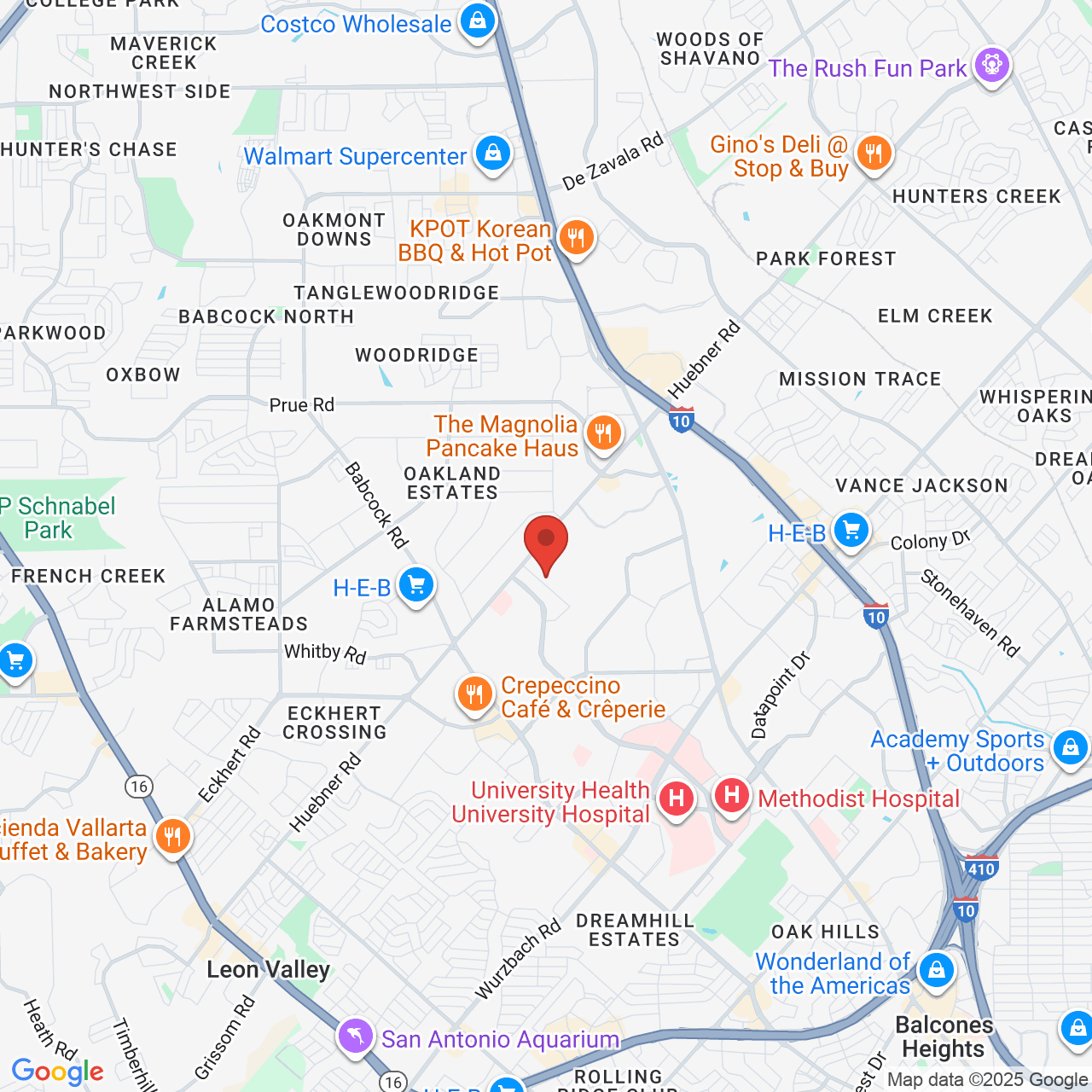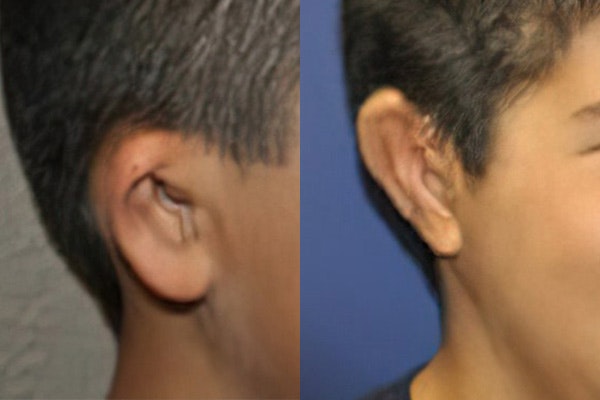MICROTIA
Microtia is a congenital ear condition where a child is born with a small, underdeveloped, or missing external ear. It can affect one or both ears and may be associated with hearing loss, especially when the ear canal is also absent (aural atresia). The Microtia - Congenital Ear Deformity Institute is the world's largest pediatric clinic specializing exclusively in children's microtia, with over 30 years of expertise.
What is microtia?
Microtia essentially means “small ear”. The word “microtia” originates from the combination of two Greek roots: “micro-” meaning “small” and “-otia” meaning “ear”. Microtia is usually accompanied by “aural atresia”, meaning lack of an ear canal. These children usually experience mild to moderate conductive hearing loss.

Microtia occurs in approximately 1 in 6,000 to 12,000 births. It is more common in males and often affects the right ear more than the left.
Microtia is classified into four grades:
- Grade 1: Many normal features of the ear are present, but the ear appears smaller. An ear canal is usually present in this type of ear deformity.
- Grade 2: The ear is missing more of the normal features, but the earlobe is present. The top of the ear is not fully developed.
- Grade 3: The top half of the ear is cartilage. The bottom half usually a normal earlobe. This is the most common type of microtia.
- Grade 4: Also called anotia, this severe form of microtia involves the total absence of the external ear. This may be accompanied by a low hairline.
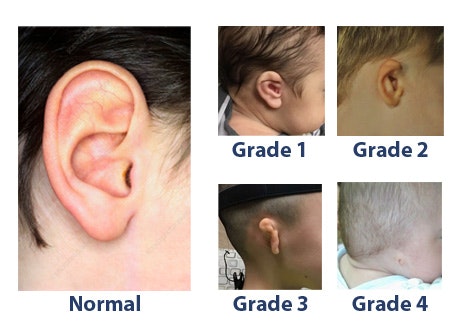
What causes microtia?
The exact cause of microtia is not fully understood although a common theory is that a small blood vessel (stapedial artery) of the developing ear gets pinched during the 7th week of pregnancy and decreases the blood flow to the developing ear, thus causing it to stop growing at that point. It may also result from genetic and environmental factors during early pregnancy. Most cases occur sporadically without a family history.
Is microtia hereditary?
Microtia is usually not inherited, but in rare cases, there may be a genetic link or family history of ear anomalies. It is recommended to seek a Geneticist specialist for a complete patient and family assessment for future risks.
Can microtia occur with other conditions?
Yes, microtia may be associated with conditions like hemifacial microsomia, Treacher-Collins syndrome and Goldenhar syndrome. However, many children with microtia are otherwise healthy.
How is microtia diagnosed?
Microtia is usually easily diagnosed at birth. When the microtia is very minor (Grade 1 microtia), it may be more difficult to diagnose. Imaging studies like a CT scan may be used to evaluate the inner ear structures and determine candidacy for hearing improvement via bone-conduction hearing aids or surgery at a later age.
What tests are needed after birth?
While the newborn with microtia is still in the hospital, a newborn hearing screening is always performed. Usually the baby with microtia will pass on the normal side and fail on the microtia side. This does not mean the patient is deaf. It just means that there is some type of hearing loss that needs to be further evaluated. Once the patient is discharged from the hospital, an auditory brainstem response test (ABR) is recommended to evaluate in more detail the function of the auditory or hearing nerve. Most patients have a normal hearing nerve, even on the side of the microtia. This means that sound is just muffled on that side without deafness. As stated above, a CT scan of the ears is performed at a later age…usually. 4-5 years of age to evaluate the anatomy of the outer, middle and inner ears to determine if the child is a possible candidate for opening up the ear canal. , audiological evaluation, and imaging such as a CT scan are commonly performed. A full ENT evaluation is also recommended.
When should my child see a microtia specialist?
Dr. Bonilla recommends consulting a microtia specialist as early as the day of birth to help parents understand the condition and outline a plan for hearing and reconstructive care. During this time, there is much stress from the parents and this is a perfect time to let the parents know that everything will be ok and that their child is not deaf. This is also a good time to give the parents a general plan for the management of the microtia as well as management of the hearing.
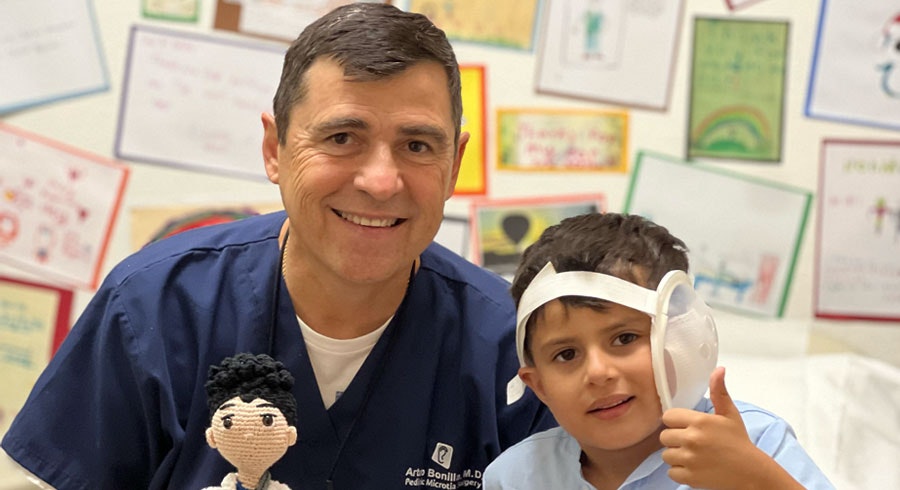
Dr. Bonilla has been treating pediatric microtia patients for over 30 years.
What are the treatment options for microtia?
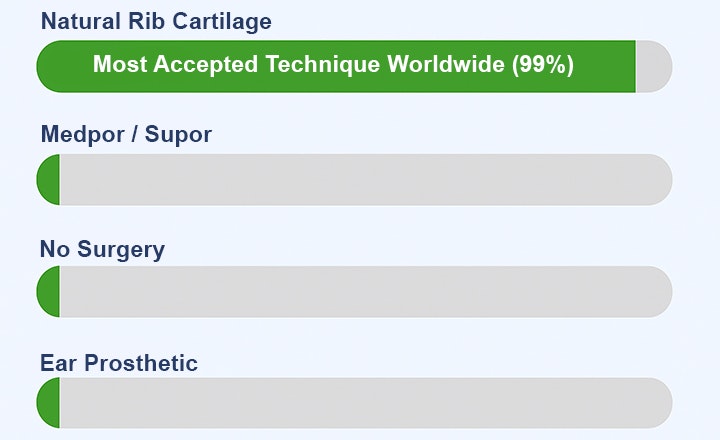
What is the best age for microtia surgery?
Surgical reconstruction typically begins between ages 6 to 7 years of age, although some surgeons choose to wait until the patient is 9-10 years of age. This varies by technique.
Which reconstruction method is best?
The best method depends on your child’s anatomy, medical history, and your surgeon’s expertise. Rib cartilage surgery (the most common and gold-standard) is natural and long-lasting, while Medpor / Supor offers earlier reconstruction but with different risks such as fracture or exposure for the life of the patient. Surgeon experience is absolutely critical using the above techniques in order to avoid a lifetime of dealing with a poor aesthetic result.
Can children with microtia hear?
Children with microtia usually have moderate to severe conductive hearing loss, especially if they also have aural atresia. However, their inner ear (cochlea) function is usually normal, and hearing can be improved with hearing devices or surgery.
What hearing devices can help?
Bone conduction devices such as a BAHA softband can immediately improve the hearing via bone-conduction on the skull. Later, the more invasive surgical hearing options are available like the bone anchored hearing aid systems by Cochlear, Oticon, Med-El, usually during the microtia reconstruction. Depending on the result of the CT scan of the ears and on the experience of the ear canal surgeon, the ear canal may also be opened (atresiaplasty).
Can ear canal surgery restore hearing?
In some children with favorable anatomy, atresia repair surgery can create a functioning ear canal and significantly improve hearing. A CT scan helps determine if this is a good option. It is crucial to be evaluated by a very experienced ear canal surgeon in order to avoid damage to the facial nerve, and to decrease the risks of ear canal scarring, etc…
Is microtia associated with psychological effects?
It is important to inform the parents of children with microtia that their lives can be perfectly normal, with or without any type of surgical intervention. Parental confidence is crucial. Dr. Bonilla always gives parents the first option of “doing no surgery at all”. It is common to be pressured to operate on all of these children with microtia, but it should be a decision of the patient as well.
It is not uncommon to receive bullying at school during school age, causing the children to lose self confidence. With early family support and positive reinforcement, the children will do very well and live normal lives without restrictions. Reconstructive surgery with a good result can also improve self-esteem.
How do I support my child emotionally or psychologically?
Encourage open conversations, connect with support groups, and consult with child psychologists or counselors if needed. Highlight your child’s strengths and talents beyond their appearance. It is important to see the “parent's guide to a child with microtia”.
Can children with microtia attend school and live normal lives?
Absolutely. With proper hearing support and care, children with microtia can thrive academically, socially, and physically like any other child.
ONE-STAGE MICROTIA RECONSTRUCTION Grade 2 Microtia
ADVANTAGES OF THE NATURAL CARTILAGE TECHNIQUE
- 99% of world microtia surgeons prefer this technique
- Made of cartilage like the natural ear (not plastic)
- No chance of fracture nor rejection like a Medpor ear
- Will grow with the patient because it is natural
Dr. Bonilla: Microtia Expert & World-Renowned Pioneer World's Only Exclusive Pediatric Microtia Surgeon
For microtia patients, nothing replaces the ear like our own living cartilage. Dr. Bonilla exclusively uses this technique in his pediatric microtia patients.

Dr. Arturo Bonilla, with 30 years of experience, has developed techniques that achieve excellent outcomes for children with microtia and atresia.
Letters From
Dr. Bonilla's Patients
Reading the letters written by our children with microtia makes our team feel appreciated and grateful. These letters are so heartwarming and fun to read, we save all of them. We are honored to care for so many children with microtia and atresia worldwide from our San Antonio pediatric microtia surgery office.

The Life of Microtia Patients Dr. Bonilla Shows That Microtia Patients May Lead A Normal Life
The pure joy our patients show after successful treatment always puts smiles on our faces. Watch one of our annual patient compilations to see the children who have undergone Dr. Bonilla's microtia treatment.
Exclusive Pediatric Microtia Clinic! Caring For Patients Worldwide
As your child's surgeon, Dr. Bonilla will use small pieces of rib cartilage to perform his advanced microtia repair technique. Ear reconstruction with rib cartilage provides a natural look, feel, and bend for your child's ear.
Dr. Bonilla's Passion Has Always Been Helping Children With Microtia!
Dr. Bonilla's advanced technology and techniques are why so many parents pick him for their children's life-changing treatment. His natural rib cartilage method, in comparison to the plastic polyethylene alternative, requires shorter surgery times, less anesthesia, and will not break since it uses living tissue. Other examples of Dr. Bonilla's innovative methods include contact laser technology, which minimizes discomfort.
We know that parents may feel undue guilt when their child has microtia. This diagnosis is by no means your fault, and you can feel comfort in knowing that we can help. In addition to our technological advancements aiding us in providing elite care, they also help keep costs down. At the Microtia - Congenital Ear Deformity Institute, we can make arrangements with most insurance companies to make your child's treatment as affordable as possible. For compassionate, world-class care from a physician who prioritizes you and your child's well-being at all times, call or contact us today.
(210) 477-3277

Dr. Bonilla Has 30 Years of Experience as an Exclusive Pediatric Microtia Surgeon
Dr. Bonilla has dedicated his entire career of over 30 years to exclusively taking care of thousands of children born with microtia and atresia. His unique surgical techniques and caring approach have led to global recognition as the leading pediatric microtia surgeon who utilizes children's own natural rib cartilage.
Your Child May Qualify
for Life-Changing Microtia Surgery
During a consultation with Dr. Bonilla, he will examine your child's ear and determine if they're a candidate for microtia surgery at our San Antonio office. If they are, our doctor will provide you with thorough pre- and post-operative instructions. If you are traveling a great distance to our San Antonio office, we can help make hotel arrangements for you. Call us if you have questions.

Families from around the globe come to San Antonio to seek treatment with Dr. Bonilla and his advanced natural cartilage techniques.
Patient Resources
It is important to us that patients, parents, and loved ones are fully informed regarding microtia and the treatment they will receive at Dr. Bonilla's Congenital Ear Institute in San Antonio, Texas. Here are some resources that can illuminate microtia and our life-changing treatment:
Major Media Recognition
Dr. Bonilla's work has been featured by many globally recognized outlets, including CNN, Fox News, CBS, ABC, NBC, Univision, and Telemundo. This is just one of the many stories highlighting his outstanding microtia treatment.
Dr. Bonilla is the only exclusive pediatric microtia surgeon in the world. He has nearly 3 decades of experience having completed thousands of microtia surgeries in children worldwide.








